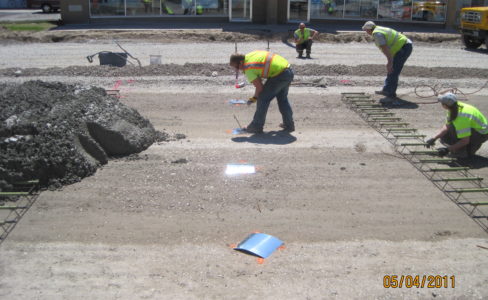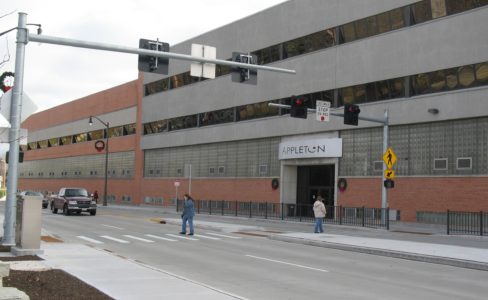Wisconsin Avenue (STH 96), Appleton, Wisconsin
City of Appleton & Wisconsin Department of Transportation / Appleton, WI

Date Completed:
October 2011
Services:
Concrete Pavement, Earthwork & Grading, Custom Crushing
Engineer:
OMNNI Associates
Award Won:
 2012 / 23rd Annual ACPA Excellence in Concrete Pavement Awards
2012 / 23rd Annual ACPA Excellence in Concrete Pavement Awards
Project Summary:
The $5.7 million dollar construction project involved reconstructing a 2 mile urban segment of Wisconsin Avenue (STH 96) from STH 47 to CTH E in the City of Appleton, Wisconsin.
Contract Amount:
$5,710,00
Project Length:
2 Miles
By the Numbers:
- 66,750 SY of 8.5 inch Concrete Pavement
- 74,200 SY of Removing Concrete Pavement
- 39,300 CY of Excavation
- 33,000 Tons of Base Aggregate
- 185,000 SF of Concrete Sidewalk and Driveways
- 19,000 SF of Colored and Stamped Concrete
About the Project
The $5.7 million dollar construction project involved reconstructing a 2 mile urban segment of Wisconsin Avenue (STH 96) from STH 47 to CTH E in the City of Appleton, Wisconsin.
The corridor has 28 intersections, over 140 driveway openings, and had a crash rate that was 2.5 times higher than the statewide average. Reconstruction of this corridor required an extraordinary level of planning and construction effort to deliver and minimize the impact on the 125+ businesses within the project limits. The design expanded the roadway to a consistent four-lane cross section with left turn lane additions and intersection geometric improvements throughout the corridor.
On-street parking was generally eliminated; however indent parking was designed along a three-block area. The project incorporated a mid-block pedestrian hybrid beacon (HAWK), which was one of the first installations in the State of Wisconsin.
The pavement design consisted of doweled JPCP 8.5-inch over 6-inch base aggregate dense. Construction began in late March of 2011. Completing the multi-staged project in one construction season required higher than normal production rates and work efforts including weekends and scheduling of concurrent controlling operations. The project utilized 3 stages of construction that included allowing local traffic into the work zone to access businesses.
The traffic section of the special provisions detailed 22 different intersection staging requirements and special access requirements for 26 commercial properties. Vinton Construction, developed a detailed project construction schedule and provided weekly schedule updates which were posted to a project website. The website provided a constant flow of information, including a Twitter feed to alert followers when new information was posted.
A true partnership was forged by WisDOT, OMNNI Associates, the City of Appleton and Vinton Construction. Every aspect of the project from conception to completion was carefully thought out, well executed, and a huge success.
The City of Appleton has a revitalized corridor which will spur business redevelopment for many years to come thanks to the commitment made by all parties involved and the use of concrete pavement.
Noteworthy Project Details
- During design of the project, many traffic control options were considered for the heavily used mid-block crossing at Appleton Papers. After extensive research the decision was made to install a pedestrian hybrid beacon (HAWK). This was one of the first installations in the State of Wisconsin
- Traffic Management section was very unique in that it broke the 2-mile project up into 3 segments, creating 3 individual smaller urban construction projects. This staging was critical for the accessibility to businesses within the construction.
- Vinton utilized a two stage mobile crusher to recycle old concrete pavements for use as roadway base. This process eliminated hundreds of truck trips that would have been required to haul away the old concrete and haul in new base aggregate which reduced carbon dioxide emissions, fuel consumption and saved on the wear and tear on the local roads.
- Vinton Construction utilized a John Deere 700 dozer equipped with a Leica GPS system to grade the project. This was the first time Vinton had utilized GPS grading on a dozer in an urban setting.






